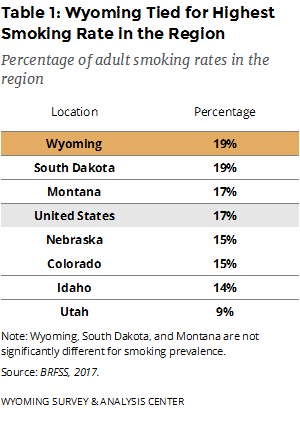Summary
Tobacco use is the leading preventable cause of premature death in the United States (U.S. Department of Health and Human Services [USDHHS], 2014). Nearly one of every five deaths in the United States is smoking related (USDHHS, 2004). Between 2005 and 2009, an average of 800 Wyoming residents died each year from tobacco use. This estimate does not include deaths attributable to secondhand smoke or smoking-attributable residential fires (Centers for Disease Control and Prevention [CDC], 2014a).
The Wyoming Tobacco Prevention and Control Program (TPCP) shares four goals with the federal tobacco prevention and control program: (a) reduce tobacco initiation (CDC, 2014b), (b) increase tobacco cessation attempts and successes (CDC, 2015a), (c) decrease exposure to secondhand smoke (CDC, 2017), and (d) eliminate tobacco-related disparities (CDC, 2014b; 2015a; 2017). Identifying those at risk for starting to smoke, use smokeless tobacco, or use electronic nicotine delivery systems (ENDS), augmenting efforts to reduce initiation of tobacco use, and increasing cessation efforts could help the Wyoming TPCP reduce smoking, smokeless tobacco use, and ENDS use. Ultimately, such changes would improve health and lower healthcare costs for many Wyoming residents.
Current Smokers
Current smokers are those who reported smoking at least 100 cigarettes in their lifetime and currently smoke every day or some days. According to the 2017 Behavioral Risk Factor Surveillance System (BRFSS), 19% of Wyoming adults smoke, a decline from 23% in 2011. For comparison, the national estimates (the median of the 50 states, the District of Columbia, and all U.S. territories). were 17% in 2017 and 21% in 2011. Wyoming, South Dakota, and Montana are in a statistical tie for the highest smoking rate in the region (Table 1).
Four Level Smoking Status
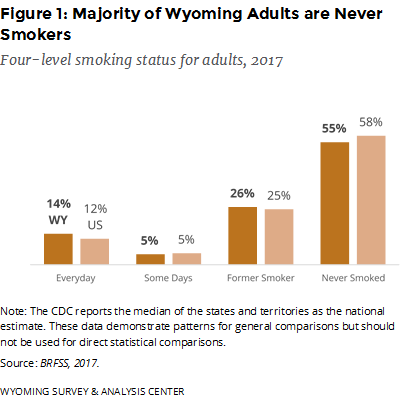
The adult population can be described in four groups based on smoking status: everyday, some-day, former, and never (Figure 1). Based on the 2017 BRFSS data for Wyoming, most Wyoming adults have never smoked (said they had not smoked at least 100 cigarettes in their lifetime). About half of the Wyoming adults who have been smokers are now former smokers. Among smokers, everyday smokers outnumber someday smokers. About four times as many Wyoming adults are current nonsmokers as are current smokers.
Age
Smoking prevalence is lower among older adults than younger adults (Figure 2). In Wyoming, the percentage of those 65 and older who smoke is the lowest of all age groups (BRFSS, 2017).
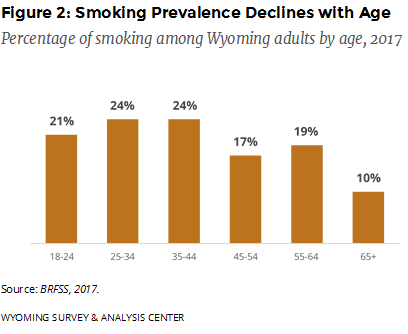
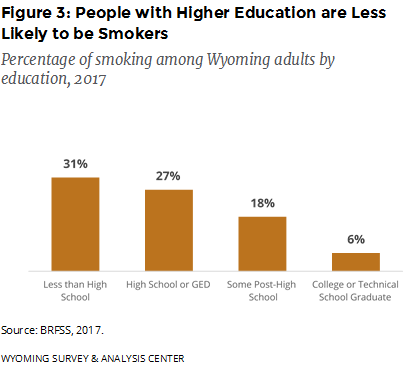
Education
For Wyoming, people with more education are less likely to be smokers (Figure 3). The percentage of those with a college or technical degree who smoke is the lowest of all education groups (BRFSS, 2017).
Annual Household Income
Wyoming adults with higher annual household incomes are less likely to be smokers (Figure 4; BRFSS, 2017).
Smokeless Tobacco
In 2017, 9% of Wyoming adults reported using chewing tobacco, snuff, or snus every day or some days, compared to 4% of U.S. adults. Wyoming’s rate of adult smokeless tobacco use was the highest in the nation. The rates in 2017 and 2013 (the oldest available year) were the same. In Wyoming, adult men (17%) are much more likely than adult women (1%) to use smokeless tobacco. Wyoming’s percentage of men who use smokeless tobacco is second highest in the nation (slightly behind West Virginia with a rate that also rounds to 17%), and compares to a national median of 7%. For Wyoming men, the slight difference between the 2017 rate and the 2013 rate (16%, the oldest available year) was not significant (Figure 5; BRFSS, 2017). CDC did not report a gender breakdown for national data.
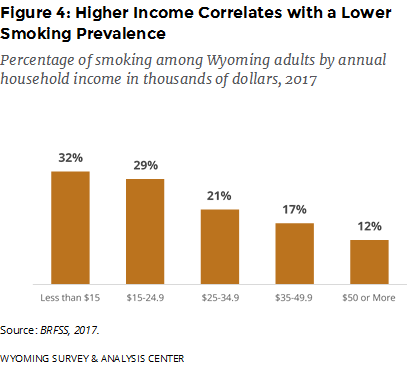
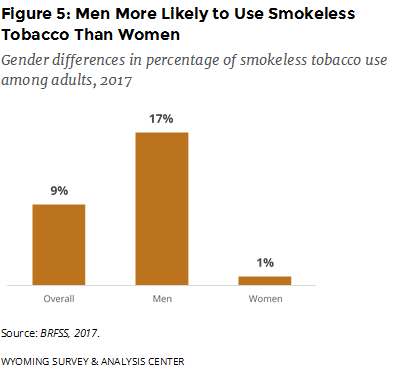
CDC (2014c) reported that, nationally, use of smokeless tobacco in 2010 was higher among workers in the mining industry (19%) than in any other industry. Mining is Wyoming’s top industry (Wyoming Business Council, n.d.).
Electronic Nicotine Delivery Systems (ENDS)
Electronic nicotine delivery systems (ENDS; also known as e-cigarettes, e-cigs, vape-pens, etc.) are battery powered devices that produce an aerosol by heating a liquid instead of producing smoke from burning tobacco. Contents of the liquid vary across products, and some models allow for customized liquids. Many ENDS liquids contain nicotine.
In 2017, 24% of Wyoming adults had tried ENDS at least once; 5% used ENDS every day or some days. The majority (61%) of Wyoming adults who reported ever trying ENDS said they tried them out of curiosity. Other common reasons for trying ENDS included using them in places where tobacco is not allowed and to replace, cut down, or quit other tobacco products (WYSAC, 2018). The U.S. Food and Drug Administration (FDA) has not approved any ENDS as a cessation aid (FDA, 2013).
Overall Health
In 2017, smokers reported poorer health than nonsmokers (BRFSS, 2017):
- 25% of Wyoming smokers reported their health was fair to poor, compared to 13% of nonsmokers. Nationally, 29% of smokers reported their health was fair to poor, compared to 17% of nonsmokers.
Smoking Among Pregnant Women and Recent Mothers
Infertility in women and complications during pregnancy are attributable to smoking. In addition, smoking during pregnancy is a risk factor of birth defects, disease, and mortality–including Sudden Infant Death Syndrome (SIDS) – among babies (CDC, 2015b).
The high prevalence of smoking among Wyoming women shortly before pregnancy suggests the importance of offering cessation services to women of child-bearing age as a way to reduce smoking during pregnancy. Overall, 18% of women in Wyoming were current smokers in 2015. In 2015, 28% of recent Wyoming mothers surveyed two to six months after a live birth reported using tobacco during the three months prior to becoming pregnant. About half of them (14% of recent mothers) reported using tobacco during the last three months of pregnancy. The rest (14% of recent mothers) reported quitting smoking during their pregnancy (Wyoming Department of Health, Public Health Division, 2017). Nationally, between 2007 and 2011, 31% of recent mothers smoked during the three months prior to their pregnancy, and 13% of recent mothers smoked during the last trimester of their pregnancy (Wyoming Department of Health, 2013).
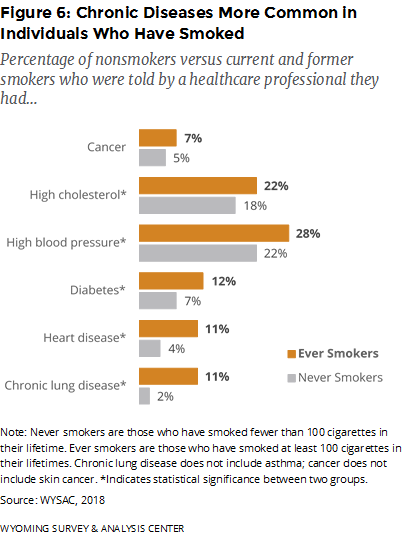 Prevalence of Chronic Diseases and Cigarette Smoking
Prevalence of Chronic Diseases and Cigarette Smoking
Tobacco use is a preventable cause of chronic diseases like heart disease, cancers, respiratory diseases, and high blood pressure in the United States (USDHHS, 2014). Chronic diseases are leading causes of death and sickness in the United States and Wyoming. In 2016, cardiovascular disease, cancer, and chronic lower respiratory diseases were the first, second, and fourth leading causes of death in Wyoming, respectively (CDC, National Center for Health Statistics, 2017).
Compared to Wyoming nonsmokers, current and former smokers were 5.5 times more likely to have been diagnosed with chronic lung disease, 2.8 times more likely to have heart disease, 1.7 times more likely to have diabetes, 1.3 times more likely to have high blood pressure, 1.2 times more likely to have high cholesterol, and 1.4 times more likely to have cancer (Figure 6; WYSAC, 2018).
References
Behavioral Risk Factor Surveillance System [Datafile 1994-2017]. (2017). Atlanta, GA: Centers for Disease Control and Prevention. Retrieved August 22, 2019, from http://www.cdc.gov/brfss/brfssprevalence/index.html.
Centers for Disease Control and Prevention. (2014a). Best Practices for Comprehensive Tobacco Control Programs – 2014. Atlanta, GA: U.S. Department of Health and Human Services, Centers for Disease Control and Prevention, National Center for Chronic Disease Prevention and Health Promotion, Office on Smoking and Health.
Centers for Disease Control and Prevention. (2014b). Preventing Initiation of Tobacco Use: Outcome Indicators for Comprehensive Tobacco Control Programs–2014. Atlanta, GA: Centers for Disease Control and Prevention, National Center for Chronic Disease Prevention and Health Promotion, Office on Smoking and Health.
Centers for Disease Control and Prevention (2014c). Smokeless tobacco use among working adults—United States, 2005 and 2010. MMWR, 63(22), 477-482.
Centers for Disease Control and Prevention. (2015a). Promoting quitting among adults and young people: outcome indicators for comprehensive tobacco control programs—2015. Atlanta, GA: Centers for Disease Control and Prevention, National Center for Chronic Disease Prevention and Health Promotion, Office on Smoking and Health.
Centers for Disease Control and Prevention. (2015b). Tobacco use and pregnancy. Retrieved March 29, 2016, from http://www.cdc.gov/reproductivehealth/tobaccousepregnancy/.
Centers for Disease Control and Prevention, National Center for Health Statistics [Data File 1999- 2016]. (2017). Underlying Cause of Death 1999-2016. Retrieved January 3, 2018, from http://wonder.cdc.gov/ucd-icd10.html
Centers for Disease Control and Prevention. (2017). Eliminating exposure to secondhand smoke: Outcome indicators for comprehensive tobacco control programs–2017. Atlanta, GA: Centers for Disease Control and Prevention, National Center for Chronic Disease Prevention and Health Promotion, Office on Smoking and Health.
U.S. Department of Health and Human Services. (2004). The health consequences of smoking: A report of the surgeon general. Retrieved December 7, 2012, from http://www.cdc.gov/tobacco/data_statistics/sgr/2004/index.htm.
U.S. Department of Health and Human Services. (2014). The health consequences of smoking – 50 years of progress: A report of the Surgeon General. Retrieved January 21, 2014, from http://www.cdc.gov/tobacco/data_statistics/sgr/50th-anniversary/index.htm.
U.S. Food and Drug Administration. (2013). FDA warns of health risks posed by e-cigarettes. Retrieved Sept 5, 2016, from http://www.fda.gov/ForConsumers/ConsumerUpdates/ucm173401.htm
Wyoming Business Council (n.d.). Targeted Industries. Retrieved on June 6, 2014, from http://wyomingbusiness.org/program/targeted-industries/1242.
Wyoming Department of Health. (2013). Maternal Smoking Fact Sheet Wyoming, 2007-2011. Cheyenne, WY: Author.
Wyoming Department of Health, Public Health Division. (2017). Wyoming Pregnancy Risk Assessment Monitoring System (PRAMS) 2015 Surveillance Report. Retrieved November 16, 2017, from https://health.wyo.gov/wp-content/uploads/2016/04/2015-PRAMS-Report.pdf
WYSAC. (2018). 2017 Wyoming Adult Tobacco Survey [Data file]. Laramie, WY: Wyoming Survey & Analysis Center, University of Wyoming.

